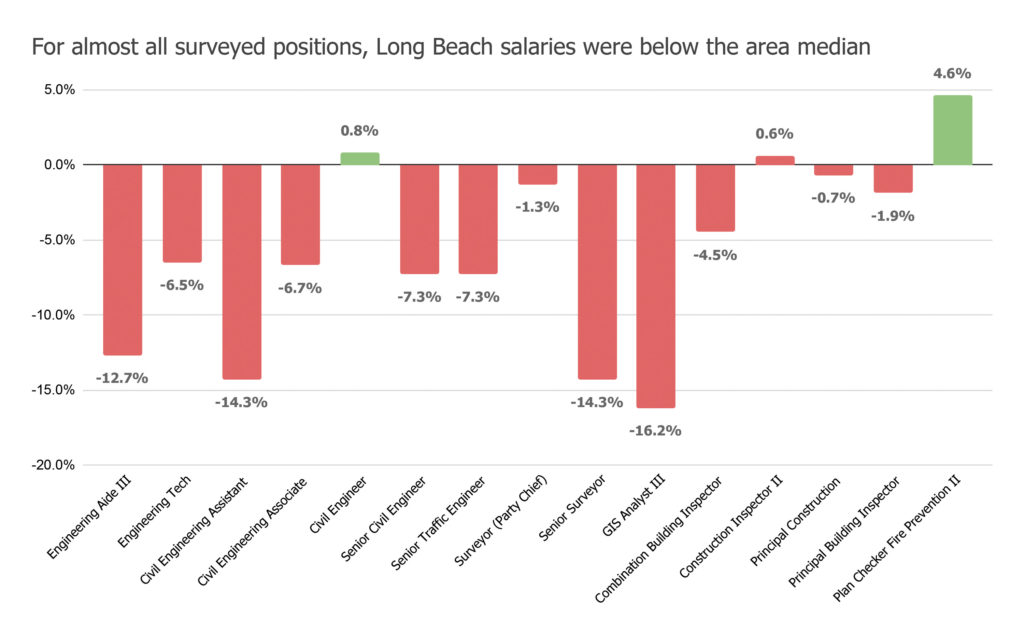A salary survey recently made public by the Long Beach Association of Engineering Employees (LBAEE) shows that salaries among the city’s engineering staff are significantly below the median salaries paid by other agencies in the region.
The study, which was conducted as a joint effort by members of the union’s board of directors and City of Long Beach Department of Human Resources staff, found that some engineering employees received up to 16% less than their peers in cities such as Anaheim, Los Angeles or Torrance. The study compared the salaries of employees based on a set of guidelines set forth by the city, which includes a list of the “Standard 10” cities to consult for comparison.

The positions to be compared are also picked according to the city’s guidelines, to ensure that human resources staff would accept the survey’s results into the record of the active contract negotiations, LBAEE President Jason Edward Rodriguez told the Business Journal. “The positions themselves have to match very closely in terms of duties and the entire salary package, so that we’re comparing apples to apples,” Rodriguez said.
The gap in pay between Long Beach engineers’ salaries and those of similar employees in surrounding cities has made it hard for the city to attract and retain talent for certain positions, Rodriguez explained. Geographic Information System (GIS) analysts are the group exhibiting the largest gap in pay between Long Beach and comparable cities at a 16.2% difference, followed by senior surveyors and civil engineering assistants, whose pay is 14.3% below the median.
Gary Newkirk, a senior surveyor at the Port of Long Beach and LBAEE union member, said he has noticed that applicant numbers for some positions included in the survey have been low and that some of his colleagues have left the city after being offered better pay somewhere else. “I know we’ve had a couple of people leave to other agencies,” Newkirk said. Still, he noted, he and most of his colleagues are happy to be working for the City of Long Beach. “Most people I work with like their jobs, like doing what they’re doing and like their employer. There’s not a whole lot of friction,” he explained.
“We understand that you can’t just give someone a 16% increase, so it makes sense that it would be done over a period of time,” Rodriguez said. For now, he said the union is hoping for a cost-of-living increase comparable to those recently approved in surrounding cities, to keep the pay gap from widening.
The consumer price index for the Los Angeles-Long Beach-Anaheim metropolitan area increased 3% compared to last year, according to the U.S. Bureau of Labor Statistics. Firefighters in Los Angeles recently agreed to a 2.5% cost-of-living adjustment (COLA) and police officers in Long Beach received a 4% salary increase, effective October 1, 2019, as part of their recent labor agreement with the city. Long Beach firefighters are expecting to see a 3% pay increase in the first year of their new contract, once it has been approved by the city council. A vote is scheduled for October 22.
Rodriguez highlighted that a majority of union members’ positions are paid for through enterprise funds, rather than the city’s General Fund. In a 2019 interview with the Long Beach Business Journal, outgoing city manager Patrick West highlighted the strength of the city’s enterprise funds. Rodriguez argued that the strength of enterprise funds, such as those operated by the harbor department and the airport, should provide room for the salary increases the union is seeking.
In addition to salary increases, the union is hoping to persuade the city to participate in the State Disability Insurance (SDI) program, Rodriguez noted. Currently, union members do not pay into the SDI program and do not receive benefits through the state program if they have to take an extended break from work for health reasons, he explained.
Instead, employees can purchase disability insurance from an outside vendor. “It’s a lot harder, a lot more expensive and you’re not getting the full umbrella [of] coverage,” Rodriguez said. Under the SDI program, employees would still be responsible for their contributions to the insurance fund and there would be no additional cost to the city, Rodriguez argued. “We’ve [heard] several stories . . . recently of people who were without insurance,” he noted. “We’re really hoping to get that.”
Dana Anderson, human resources manager at the city’s human resources department, said she could not comment on the details of the ongoing negotiations. “The city is currently engaged in good faith negotiations with the Association of Long Beach Engineers and cannot discuss the specifics while in active discussions,” Anderson said in an email to the Business Journal.
